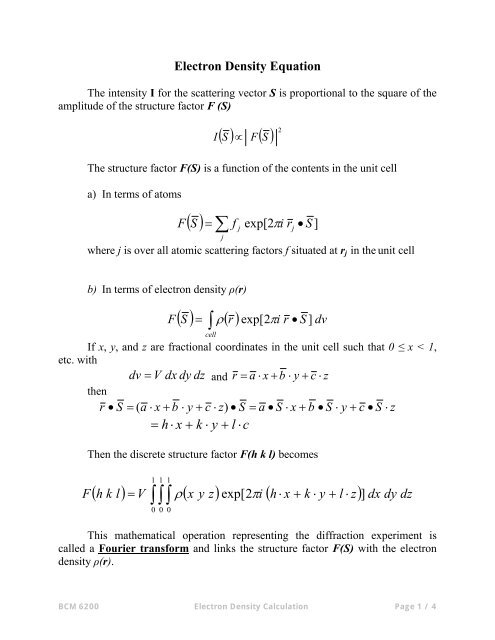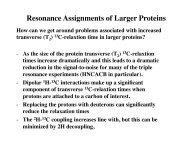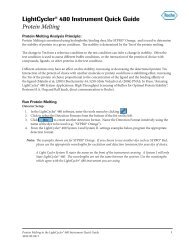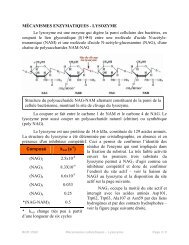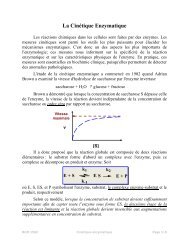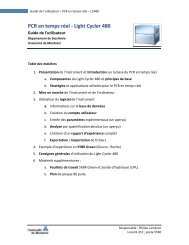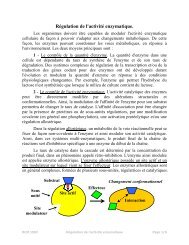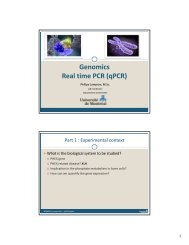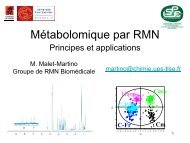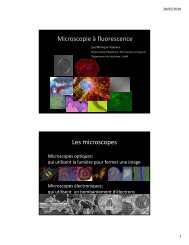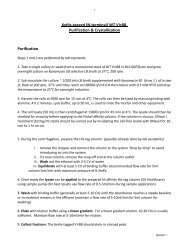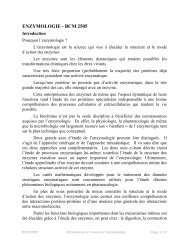Electron density equations.pdf
Electron density equations.pdf
Electron density equations.pdf
Create successful ePaper yourself
Turn your PDF publications into a flip-book with our unique Google optimized e-Paper software.
<strong>Electron</strong> Density EquationThe intensity I for the scattering vector S is proportional to the square of theamplitude of the structure factor F (S)( S ) F( S ) 2I ∝The structure factor F(S) is a function of the contents in the unit cella) In terms of atomsF( S ) = ∑ f exp[ 2πi r • S ]jjwhere j is over all atomic scattering factors f situated at r j in the unit celljb) In terms of electron <strong>density</strong> ρ(r)F( S ) = ∫ ρ ( r ) exp[ 2πir • S ] dvcellIf x, y, and z are fractional coordinates in the unit cell such that 0 ≤ x < 1,etc. withdv = V dx dy dz and r = a ⋅ x + b ⋅ y + c ⋅ zthenr • S = ( a ⋅ x + b ⋅ y + c ⋅ z)• S = a • S ⋅ x + b • S ⋅ y + c • S ⋅ z= h ⋅ x + k ⋅ y + l ⋅cThen the discrete structure factor F(h k l) becomes1( h k l) = V ∫∫∫ρ( x y z) exp[2πi( h ⋅ x + k ⋅ y + l ⋅ z) dx dy dzF ]01010This mathematical operation representing the diffraction experiment iscalled a Fourier transform and links the structure factor F(S) with the electron<strong>density</strong> ρ(r).BCM 6200 <strong>Electron</strong> Density Calculation Page 1 / 4
Phase ProblemFor every Fourier transform, there exists an inverse Fourier transformexpressing the electron <strong>density</strong> ρ(r) in terms of the structure factor F(S) and whichis written as:1ρ )V( x y z) = ∑∑∑F( h k l) exp[ −2πi( h ⋅ x + k ⋅ y + l ⋅ c ]h k lNote because of the Laue conditions, the discrete structure factor F(h k l) isused in the transform and the integration has been replaced by a summation.If the discrete structure factor F(h k l) is expressed in terms of a magnitude|F| and phase angle α, it becomes:thenF( h k l) = F( h k l) exp [ iα( h k l)]1ρ +V( x y z) = ∑∑∑ F( h k l) exp[ −2πi( h ⋅ x + k ⋅ y + l ⋅ c) iα( h k l)]h k lCalculation of the electron <strong>density</strong> at every position (x y z) then requiresknowledge of F(h k l). The structure factor however is not completely specifiedfrom the measurement process because only |F(h k l)| is determined from theobserved intensity, the phase of the ‘reflection’ α( h k l) is lost in the measurementprocess. Without the phase, the electron <strong>density</strong> cannot be calculated. This is calledtheBCM 6200 Phase Problem Page 2 / 4
Data ReductionThe integrated intensity I (h k l) for a crystal rotated with angular velocityω, eg. (°/sec), through the reflection position is:I3λ= ω ⋅V2( h k l) × ⎜ ⎟ × V × I × L×P×A×F( h k l) 22unitcell2⎛ e⎜⎝ mc2⎞⎟⎠crystalwhere- λ is the wavelength- V unit cell is the volume of the unit cell- V crystal is the volume of the scattering crystal- I 0 is the intensity of the incident beam- L is the Lorentz factor- P is a polarization factor- A is the absorption factor- |F(h k l)| is the structure factor amplitudeNotes:2⎛ e ⎞1. The term ⎜ × I × Pmc⎟2 0⎝ ⎠electron.20represents the total intensity scattered by a point32λ ⎛ e ⎞2. For each diffraction experiment, this term × × V I22 crystal×0V⎜unitcellmc⎟ω ⋅ ⎝ ⎠constant.Data reduction involves correcting for experimental factors that are specificfor each reflection and include the Lorentz factor L, absorption A, and polarizationP. The resultant intensity is then represented as( h k l) = C × L×P×A F( h k l) 2I ×where C is an arbitrary scale factor that includes all terms that are constantfor each experiment.2isBCM 6200 Data Reduction Page 3 / 4
The structure factor amplitude |F(h k l)| can then be extracted from themeasured intensity I (h k l) asF( h k l)=( h k l)IC × L × P ×ABCM 6200 Data Reduction Page 4 / 4


